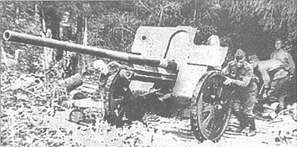
| Year | 1937 |
| Weapon Type | Light Field Gun |
| Origin & Designer | Russia/Grabin |
| Numbers Produced | 2.932 |
| Crew | 6 |
| Calibre | 76.2mm (76.2x385R) |
| Elevation | -5° to +75° |
| Traverse | 60° |
| Breech | Vertical Wedge |
| Recoil | Hydropneumatic |
| Gun Sight | [@gun_sight] |
| Gun Mount | [@gun_mounts] |
| Carriage | Split Trail |
| Trailers | [@trailers] |
| Gun Shield | 3.5mm |
| Armoured Plate | [@armoured_plate] |
| Barrel Length | 3.680mm (L/51.2) |
| Overall Length | 7.12m |
| Width | 1.93m |
| Height | 1.71m |
| Weight | Weight in Traction: 2.820 kg Weight in Action: 1.620 kg |
| Round Weight | HE: 6.5 kg AP: 6.3 kg |
| Muzzle Velocity | HE: 690 m/s AP: 706 m/s |
| Feed | [@feed] |
| Magazine Capacity | [@magazine_capacity] |
| Practical Rate of Fire | [@practical_rate_of_fire] |
| Rate of Fire | 12-15 r.p.m. |
| Maximum Rate of Fire | [@maximum_rate_of_fire] |
| Maximum Ceiling | [@maximum_ceiling] |
| Maximum Ground Range | [@maximum_ground_range] |
| Maximum Range | 13.600m |
| Armour Penetration | 75mm @ 500m @ 30° |
| Traction | Motorised |
| Variants | [@variants] |
| Notes | The 76.2mm F-22 was the main Soviet divisional gun during the late 1930s and early 1940s. It was originally designed as a universal gun which could be used in both field artillery and anti-aircraft roles. It was heavy for a field gun but was issued as a replacement for the old M.1902/30 field gun. It was issued to field regiments at divisional level and saw service against the Finns and Japanese before facing the Germans in 1941. |